Are dragons real?
Ask anyone you meet that question and the overwhelming answer will be, “No, of course not,” as if considering such a concept would be childish or ridiculous. The current, fashionable mode of thinking tends to obey the dogma of science that dictates its perspective is based somehow on “irrefutable fact.” If physical 3-D evidence for a creature has not been found or properly identified (at least publicly), then the being must be a conjuring of more primitive, not-terribly-smart people. This seems to be the prevalent attitude of scientists who control salaries as well as academicians who conjecture about human mythology or “fantasy” fiction. Rather arrogant and exceedingly short-sighted, if you ask me.
If you fall into this camp, I invite you to stand back for a moment from your current assumptions and take a look at the dragon phenomenon within the human psyche.
I find it striking that just about every man, woman, and child on the planet knows what dragons are and what they look like. It appears that the same has been true through much of recorded human history. How can I claim this? Because they’re frigging everywhere in legends, oral histories, religious storytelling, artwork, and contemporary books and media.
If we were able to directly ask others in history whether dragons were real, most would undoubtedly reply, “Of course.” They had either SEEN them or held unshakable convictions about the nature, appearance, and personalities of “the gods” or, in some cultures, “the demons.” See my posts “Depictions of Benevolent Dragons” and “Depictions of Gods or Humans Killing Reptiles.“
Dragons show up in some of the oldest known texts and imagery humans have created.
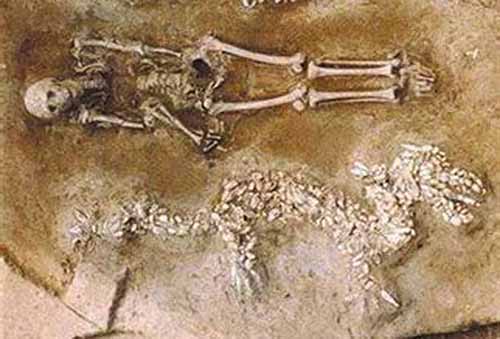
A dragon figure in shells was found in a burial site in the Chinese Yangshao culture dating back 7000 years.
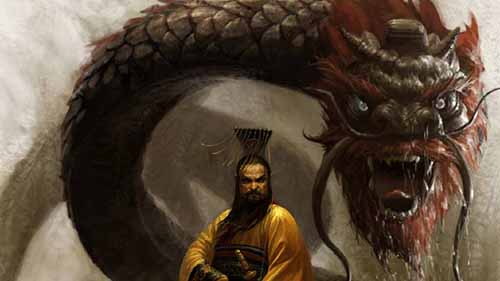
Oriental dragons represented supreme celestial and terrestrial power, wisdom, and strength while many Chinese emperors claimed to be descended from dragons.
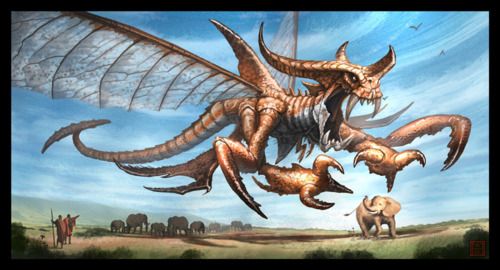
The African dragon had a special stone in their brains called the Dracontias which had healing properties and gave them magical powers, including the ability to fly.
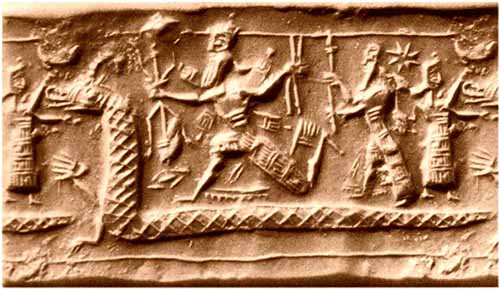
Sumerian legends tell of the mother goddess Tiamat, the dragon, being blown out of the sky by Marduk, one of her descendants.
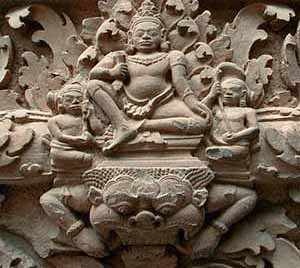
The Vedas describe the god Indra vanquishing the dragon Vritra and his mother Danu.
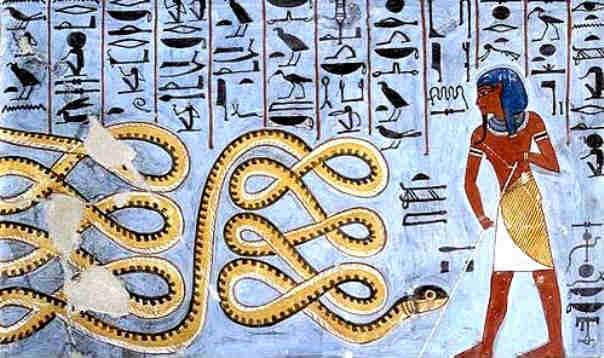
In Egypt, Apep, “the evil lizard” and the arch enemy of the sun god Ra, was considered all-powerful and could never be completely destroyed, only temporarily defeated.
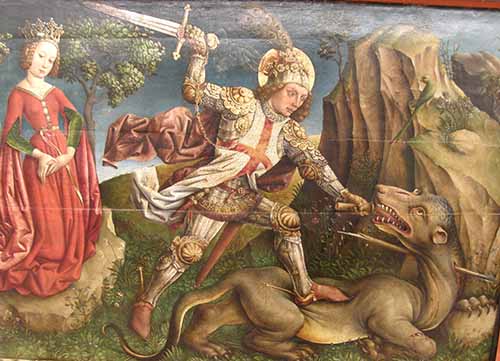
St. George, an early Christian martyr and the patron saint of England, Portugal, Georgia, Lithuania, and Greece, was supposed to have rescued a woman from a hungry dragon.
We also seem to be experiencing a widespread resurgence of dragon figures within storytelling over the last few decades.
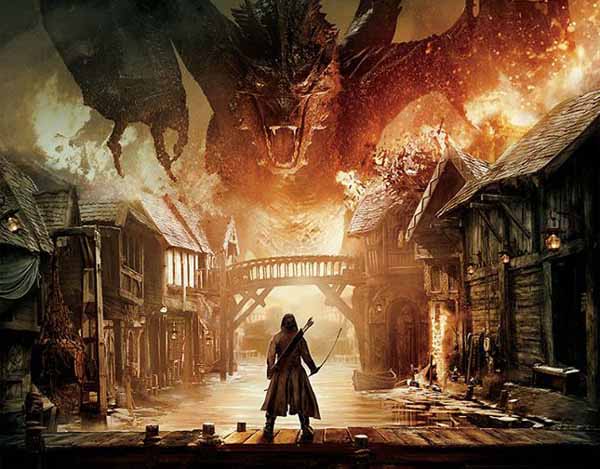
Fire-breathing Smaug faces Bard in Peter Jackson’s rendition of Tolkien’s classic story The Hobbit.
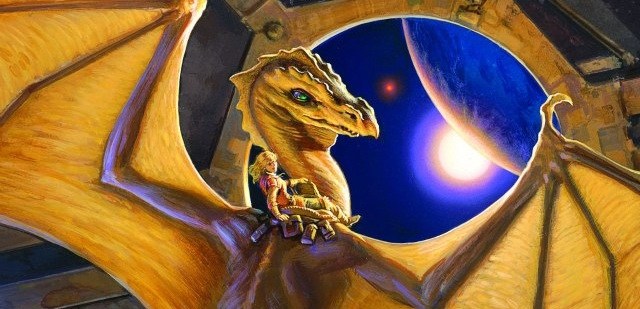
This striking image of a dragon and human rider in a spacecraft was painted by Michael Whelan for the cover of A Tribute to Anne McCaffrey and Pern.
The above sampling is a very small representation of the thousands of stories and images we have of these huge, intelligent, sometimes elegant, sometimes brutal reptilian beings. Dragons consume our thoughts, they fire our imagination, they’re in our blood, quite literally.
Just what is going on? Why do people have such an obsessive fascination with creatures who supposedly do not exist? Why do we spend so much energy theorizing about who they are, what kind of abilities they possess, and what their relationship with humanity might be? These are no small questions.
The countless depictions of dragons in human history represent something much more profound than trivial fantasies to be dismissed.
The probability that dragon entities are quite, quite real is exceedingly high. The collective mind behind this long-running, pervasive phenomenon is unmistakable. It is the signature of conscious beings, resonant voices, yelling at us through a bullhorn. Our blood codes are speaking, or rather, these entities are speaking through them. This is clear evidence, if you have the intelligence to understand that there is more to existence than physical manifestation and the sensibilities to see and hear the obvious. If we look at this phenomenon head on, especially in light of the recent explosion of dragon appearances, it is very apparent that someone wants to be acknowledged.
When we examine the patterns within the broad array of dragon tales and images, we see many suggestions about who these beings might be. Many stories around the planet attribute wisdom, learning, weather and geologic events, or healing to benevolent dragons, sometimes with very specific names and abilities. To some, these beings represent power, good fortune, wealth.
The Chinese were on the right track, at least partially, with the claims that emperors were the descendants of dragons who had the ability to manifest physically and mate with humans. Certain European bloodlines make this same claim about themselves, although the “right to rule” assertion by both lines, even if it is believed to have been granted by dragons, is absurd and has no place in a balanced culture.
The reality of who or what was created or sired by dragons may be much more vast than anyone imagines. I have encountered theories which assert that these entities were the original “creator gods” of all physical life on the planet and perhaps elsewhere, beings who infused their own consciousness into their creations. I myself have no doubt that someone quite brilliant designed the magnificent vessels which house the play of consciousness in and out of physical reality. We see the incredible intricacy and cooperation among the moving pieces of our world every day we breathe.
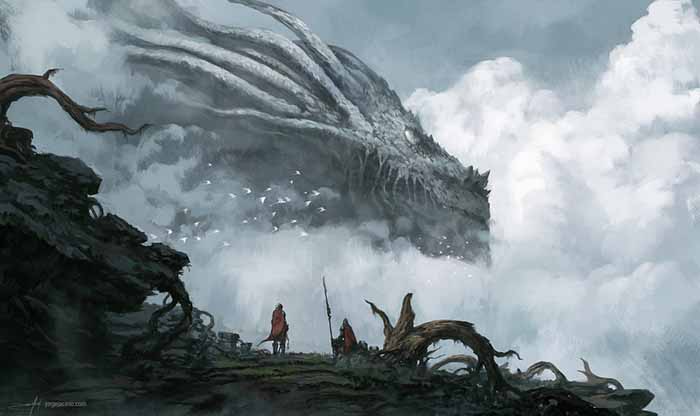
Painting by Jorge Jacinto
On the negative side, the pervasive repetition of dragons portrayed as evil monsters to be killed or “cast down” has been drummed into much of humanity for millennia. Religions preach that evil creatures or demons who reside underground, often depicted as dragons or serpents, are the enemies of humanity and god-with-a-capital-g. The theme has resurfaced in recent fantasy novels which describe evil beings who were sealed away and seals that are in danger of coming down.
Repetitive legends hold reflections of real, core events, so why do we have such vivid stories of underground hells and dangerous reptilian entities? Has someone been imprisoned within the earth? Was there a war or wars for dominion over the planet? Did the “ancient ones” or “old gods” lose the battle and watch their creations taken over and altered by off-world beings? Were they sealed away and turned into festering, angry demons while the last of their physical forms were hunted down and killed? Just who exactly were the victors, the “new gods” so intent on owning this place? Are they still here, still players in the game of ownership? Are they the ones who have steered a portion of humanity into believing the old gods are evil and to be feared? Victors as a rule tend to twist accounts to show themselves as the “good guys.”
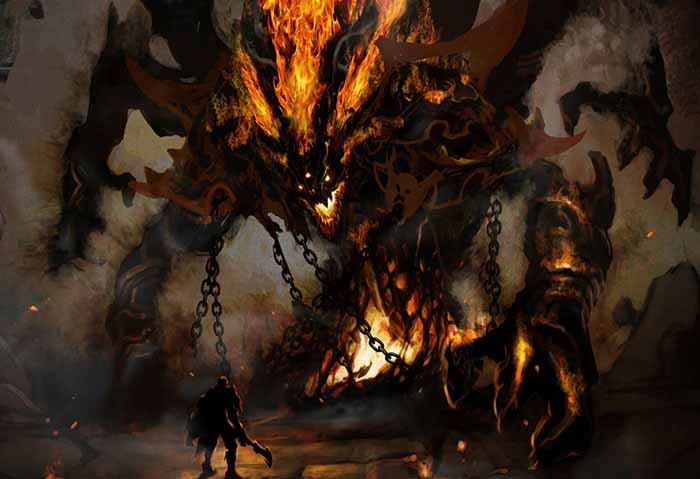
We can blame a portion of ill will toward the old gods to vicious propaganda, but there are also deep truths to be found in the negative stories of dragons. At least some of these entities have a real history of playing god and terrorizing, killing, and eating humans. Our history is rife with repetitive blood and gore, animal and human sacrifices to “gods,” often reptilian, as evidenced in countless sites and caves all over the globe. Mankind has been herded into terrible wars or conflicts in which blood was violently spilled into the ground, again and again. The global elite of humanity has been bred, manipulated, possessed, and used as willing tools to provide the fuel for a very obvious addiction by someone to blood and violence. And just look at the billions of animals butchered every year to feed humans who do not need to eat them to be healthy. Eating violence keeps us violent.
Why are people taught that they are entitled to kill? Or herded like sheep to maintain the kill-the-bad-guy mentality? For all our arrogant beliefs that humanity is somehow the high point of evolution, why have we been unable to stop ourselves from slaughtering animals, raping the planet, or murdering each other? And right alongside those questions comes this: why is the current mindset so bent on making sure people deny the existence of these creatures?
It’s pathetically simple. It perpetuates the killing — for beings who need it.
It seems to me that we have a real mess here. The answers to who dragons really are and what happened to them are not cut and dry. The explanations as to what they have done to humanity and other life on the planet may be complicated and varied.
All of these entities have names, personalities, histories, emotions, wounds, transgressions.
We have a long history with dragons, with horrors and blood on both sides. It is quite possible, no, probable, that some of our progenitors are stuck and mentally ill, locked in a damaging addiction — which keeps US stuck. The only way to cure such a terrible affliction and move forward is to look the problem straight in the eye and deal with it, one entity at a time. If indeed we are fragments of dragon consciousness who infused themselves into their creations, then we’re dealing with a portion of ourselves and it’s up to us to heal it.
Think about it. No, more importantly, feel about it. A dragon is staring you in the face, laughing, or screeching, waiting for you to realize it’s there. Will it eat you? Or speak to you? Or tell you to go have a steak? What does it want? Can you see it for who it really is or are you blinded by what you want it to be? How will you come to terms with a being far beyond your own abilities? Embrace it? Learn from it? Forgive it? Feel threatened and try to kill it? Or will you be strong enough to hold onto yourself and help it change, maybe even remember how to love?
I, for one, as a current member of the human race, am tired of the lies and bullshit. The worn-out old game of manipulating humans underlies everything that we see happening in our world today. Strangely enough, in the midst of all our gadgets, electronics, and pompous intentions to take humanity-as-it-stands into space, we have an exponential blossoming of dragons vying for our attention. Why is that?
Maybe, just maybe, these old beings need us to finally grow up enough to acknowledge them, become their equals, and help them design a new reality for themselves and for us. This is why I write. My science fantasy fiction is centered around the T’nari dragon entities and their incarnations who are out to clean up the messes their clan has made within their own creations. It’s my own contribution to opening up new solutions to the reptilian dilemma. Someone told me ages ago that I’m not necessarily writing for humans alone. I have a sneaking feeling that same someone is helping me.

Erin MacMichael is a visionary science fiction author and artist, creator of the T'nari Renegades series of novellas, novels, covers, and artwork. Her lifelong quest has been to explore past the boundaries of conventional thinking and figure out what really has transpired on this planet. She has traveled extensively throughout the world and lives in the Pacific Northwest with her marvelous offspring.
Are dragons real?
Ask anyone you meet that question and the overwhelming answer will be, “No, of course not,” as if considering such a concept would be childish or ridiculous. The current, fashionable mode of thinking tends to obey the dogma of science that dictates its perspective is based somehow on “irrefutable fact.” If physical 3-D evidence for a creature has not been found or properly identified (at least publicly), then the being must be a conjuring of more primitive, not-terribly-smart people. This seems to be the prevalent attitude of scientists who control salaries as well as academicians who conjecture about human mythology or “fantasy” fiction. Rather arrogant and exceedingly short-sighted, if you ask me.
If you fall into this camp, I invite you to stand back for a moment from your current assumptions and take a look at the dragon phenomenon within the human psyche.
I find it striking that just about every man, woman, and child on the planet knows what dragons are and what they look like. It appears that the same has been true through much of recorded human history. How can I claim this? Because they’re frigging everywhere in legends, oral histories, religious storytelling, artwork, and contemporary books and media.
If we were able to directly ask others in history whether dragons were real, most would undoubtedly reply, “Of course.” They had either SEEN them or held unshakable convictions about the nature, appearance, and personalities of “the gods” or, in some cultures, “the demons.” See my posts “Depictions of Benevolent Dragons” and “Depictions of Gods or Humans Killing Reptiles.“
Dragons show up in some of the oldest known texts and imagery humans have created.

A dragon figure in shells was found in a burial site in the Chinese Yangshao culture dating back 7000 years.

Oriental dragons represented supreme celestial and terrestrial power, wisdom, and strength while many Chinese emperors claimed to be descended from dragons.

The African dragon had a special stone in their brains called the Dracontias which had healing properties and gave them magical powers, including the ability to fly.

Sumerian legends tell of the mother goddess Tiamat, the dragon, being blown out of the sky by Marduk, one of her descendants.

The Vedas describe the god Indra vanquishing the dragon Vritra and his mother Danu.

In Egypt, Apep, “the evil lizard” and the arch enemy of the sun god Ra, was considered all-powerful and could never be completely destroyed, only temporarily defeated.

St. George, an early Christian martyr and the patron saint of England, Portugal, Georgia, Lithuania, and Greece, was supposed to have rescued a woman from a hungry dragon.
We also seem to be experiencing a widespread resurgence of dragon figures within storytelling over the last few decades.

Fire-breathing Smaug faces Bard in Peter Jackson’s rendition of Tolkien’s classic story The Hobbit.

This striking image of a dragon and human rider in a spacecraft was painted by Michael Whelan for the cover of A Tribute to Anne McCaffrey and Pern.
The above sampling is a very small representation of the thousands of stories and images we have of these huge, intelligent, sometimes elegant, sometimes brutal reptilian beings. Dragons consume our thoughts, they fire our imagination, they’re in our blood, quite literally.
Just what is going on? Why do people have such an obsessive fascination with creatures who supposedly do not exist? Why do we spend so much energy theorizing about who they are, what kind of abilities they possess, and what their relationship with humanity might be? These are no small questions.
The countless depictions of dragons in human history represent something much more profound than trivial fantasies to be dismissed.
The probability that dragon entities are quite, quite real is exceedingly high. The collective mind behind this long-running, pervasive phenomenon is unmistakable. It is the signature of conscious beings, resonant voices, yelling at us through a bullhorn. Our blood codes are speaking, or rather, these entities are speaking through them. This is clear evidence, if you have the intelligence to understand that there is more to existence than physical manifestation and the sensibilities to see and hear the obvious. If we look at this phenomenon head on, especially in light of the recent explosion of dragon appearances, it is very apparent that someone wants to be acknowledged.
When we examine the patterns within the broad array of dragon tales and images, we see many suggestions about who these beings might be. Many stories around the planet attribute wisdom, learning, weather and geologic events, or healing to benevolent dragons, sometimes with very specific names and abilities. To some, these beings represent power, good fortune, wealth.
The Chinese were on the right track, at least partially, with the claims that emperors were the descendants of dragons who had the ability to manifest physically and mate with humans. Certain European bloodlines make this same claim about themselves, although the “right to rule” assertion by both lines, even if it is believed to have been granted by dragons, is absurd and has no place in a balanced culture.
The reality of who or what was created or sired by dragons may be much more vast than anyone imagines. I have encountered theories which assert that these entities were the original “creator gods” of all physical life on the planet and perhaps elsewhere, beings who infused their own consciousness into their creations. I myself have no doubt that someone quite brilliant designed the magnificent vessels which house the play of consciousness in and out of physical reality. We see the incredible intricacy and cooperation among the moving pieces of our world every day we breathe.

Painting by Jorge Jacinto
On the negative side, the pervasive repetition of dragons portrayed as evil monsters to be killed or “cast down” has been drummed into much of humanity for millennia. Religions preach that evil creatures or demons who reside underground, often depicted as dragons or serpents, are the enemies of humanity and god-with-a-capital-g. The theme has resurfaced in recent fantasy novels which describe evil beings who were sealed away and seals that are in danger of coming down.
Repetitive legends hold reflections of real, core events, so why do we have such vivid stories of underground hells and dangerous reptilian entities? Has someone been imprisoned within the earth? Was there a war or wars for dominion over the planet? Did the “ancient ones” or “old gods” lose the battle and watch their creations taken over and altered by off-world beings? Were they sealed away and turned into festering, angry demons while the last of their physical forms were hunted down and killed? Just who exactly were the victors, the “new gods” so intent on owning this place? Are they still here, still players in the game of ownership? Are they the ones who have steered a portion of humanity into believing the old gods are evil and to be feared? Victors as a rule tend to twist accounts to show themselves as the “good guys.”

We can blame a portion of ill will toward the old gods to vicious propaganda, but there are also deep truths to be found in the negative stories of dragons. At least some of these entities have a real history of playing god and terrorizing, killing, and eating humans. Our history is rife with repetitive blood and gore, animal and human sacrifices to “gods,” often reptilian, as evidenced in countless sites and caves all over the globe. Mankind has been herded into terrible wars or conflicts in which blood was violently spilled into the ground, again and again. The global elite of humanity has been bred, manipulated, possessed, and used as willing tools to provide the fuel for a very obvious addiction by someone to blood and violence. And just look at the billions of animals butchered every year to feed humans who do not need to eat them to be healthy. Eating violence keeps us violent.
Why are people taught that they are entitled to kill? Or herded like sheep to maintain the kill-the-bad-guy mentality? For all our arrogant beliefs that humanity is somehow the high point of evolution, why have we been unable to stop ourselves from slaughtering animals, raping the planet, or murdering each other? And right alongside those questions comes this: why is the current mindset so bent on making sure people deny the existence of these creatures?
It’s pathetically simple. It perpetuates the killing — for beings who need it.
It seems to me that we have a real mess here. The answers to who dragons really are and what happened to them are not cut and dry. The explanations as to what they have done to humanity and other life on the planet may be complicated and varied.
All of these entities have names, personalities, histories, emotions, wounds, transgressions.
We have a long history with dragons, with horrors and blood on both sides. It is quite possible, no, probable, that some of our progenitors are stuck and mentally ill, locked in a damaging addiction — which keeps US stuck. The only way to cure such a terrible affliction and move forward is to look the problem straight in the eye and deal with it, one entity at a time. If indeed we are fragments of dragon consciousness who infused themselves into their creations, then we’re dealing with a portion of ourselves and it’s up to us to heal it.
Think about it. No, more importantly, feel about it. A dragon is staring you in the face, laughing, or screeching, waiting for you to realize it’s there. Will it eat you? Or speak to you? Or tell you to go have a steak? What does it want? Can you see it for who it really is or are you blinded by what you want it to be? How will you come to terms with a being far beyond your own abilities? Embrace it? Learn from it? Forgive it? Feel threatened and try to kill it? Or will you be strong enough to hold onto yourself and help it change, maybe even remember how to love?
I, for one, as a current member of the human race, am tired of the lies and bullshit. The worn-out old game of manipulating humans underlies everything that we see happening in our world today. Strangely enough, in the midst of all our gadgets, electronics, and pompous intentions to take humanity-as-it-stands into space, we have an exponential blossoming of dragons vying for our attention. Why is that?
Maybe, just maybe, these old beings need us to finally grow up enough to acknowledge them, become their equals, and help them design a new reality for themselves and for us. This is why I write. My science fantasy fiction is centered around the T’nari dragon entities and their incarnations who are out to clean up the messes their clan has made within their own creations. It’s my own contribution to opening up new solutions to the reptilian dilemma. Someone told me ages ago that I’m not necessarily writing for humans alone. I have a sneaking feeling that same someone is helping me.

Erin MacMichael is a visionary science fiction author and artist, creator of the T'nari Renegades series of novellas, novels, covers, and artwork. Her lifelong quest has been to explore past the boundaries of conventional thinking and figure out what really has transpired on this planet. She has traveled extensively throughout the world and lives in the Pacific Northwest with her marvelous offspring.

Erin MacMichael is a visionary science fiction author and artist, creator of the T'nari Renegades series of novellas, novels, covers, and artwork. Her lifelong quest has been to explore past the boundaries of conventional thinking and figure out what really has transpired on this planet. She has traveled extensively throughout the world and lives in the Pacific Northwest with her marvelous offspring.

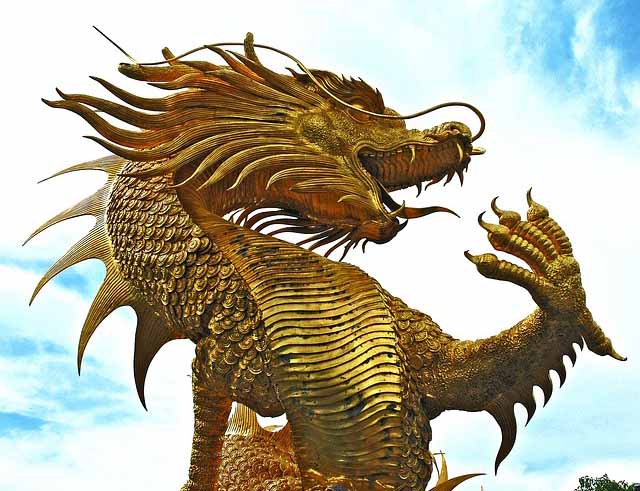
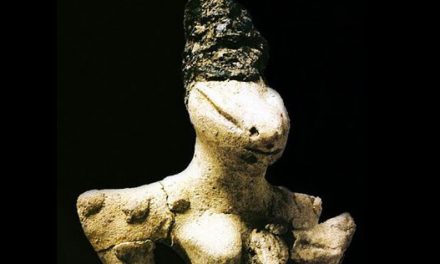
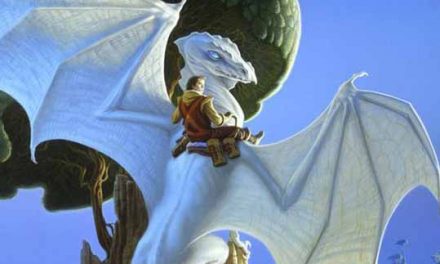
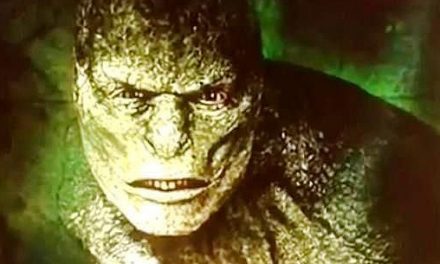
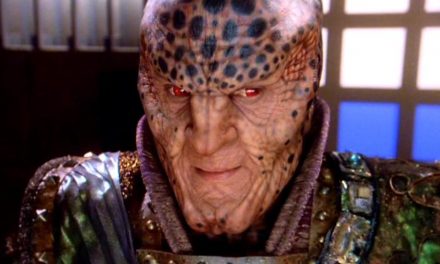
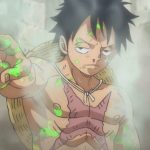
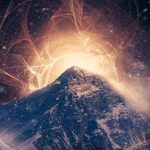


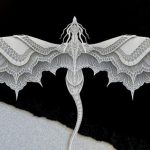

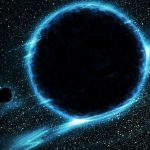


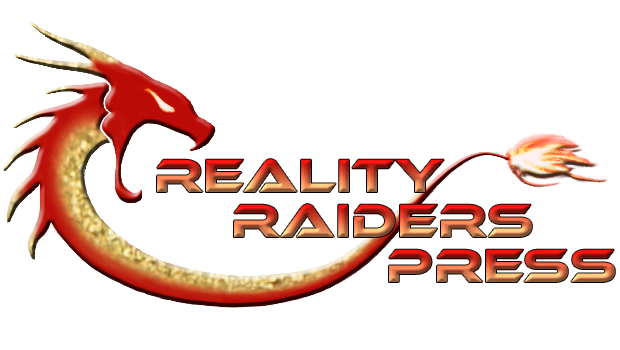
0 Comments